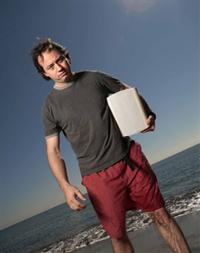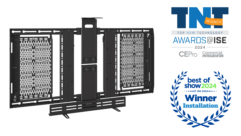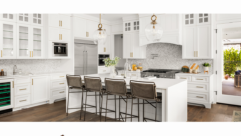

Going to Extremes: AV and the Great Outdoors
Cruise ship sailing the high seas, an outdoor arena that hosts year-round events, and a theme park with high-speed water rides. They all seem like idyllic getaways, but these harsh environments can be devastating to an AV system.
CRUISE SHIP SAILING THE HIGH seas, an outdoor arena that hosts year-round events, and a theme park with high-speed water rides. They all seem like idyllic getaways, but these harsh environments can be devastating to an AV system. Temperature extremes, direct moisture, humidity, and salt water are just a few elements that cause equipment damage—and ultimately system failure.
To combat AV equipment degradation in harsh environments, audio and video manufacturers have introduced a range of products designed for exposure to the elements, touting descriptive adjectives such as weather-protected, weather-resistant, weatherproof, all-weather, water-resistant, and waterproof. For a systems integrator, however, these various distinctions can be confusing. Although some AV vendors are starting to certify their products under one of several ratings systems (see “Ratings Recognition,” page 42), most still do not.
Bill Weir often installs AV equipment at seaside locations near Los Angeles. Sometimes he employs his own methods for combatting the elements.
Credit: KELLY FAJACK | WPN
“These descriptions are a nice play on words, and companies tend to use those words interchangeably,” says Scott Ikier, president of Western Slope Pro Audio, a design/build firm with offices in Montrose, Colo., and Tucson, Ariz. “But I find that most manufacturers are not trying to mislead anyone. There are some products that are truly waterproof and have the correct rating, but the bulk of the market is really just water-resistant.”
How do audiovisual products measure up when it comes to performing in extreme AV environments? When you get down to specifics, weatherproofing AV gear means different things for different products.
AMAZING AUDIO APPLICATIONS
Ikier—whose territory includes the snowy slopes of Vail in southwest Colorado, Rocky Mountain National Park, and the infamous sulfur-laced atmosphere from nearby oil wells in Cody, Wyo.—often has audio systems that are exposed to dust, temperature extremes, chemicals, and caustic elements. For caustic environments, he either sprays or brushes a conformal coating onto parts of the loudspeaker—a coating that has been deemed a hazardous material by the FDA and is very difficult to acquire. “It won’t prevent destruction, but it will delay degradation,” he says. “But there is nothing you can do for moving parts like the pots and faders on a mixer.”
Michael Gardner, owner of Seattle Pro Audio in Seattle, also has a wealth of experience dealing with weather extremes and plenty of moisture. “The label doesn’t matter; my use of a weather-protected loudspeaker is based on previous experience,” says Gardner, who does not rely on guidelines from the manufacturer to weatherproof his systems. “It must meet sonic needs as well as weather. A seasoned professional knows how to assess the situation and address any problems.”
At the Emerald Downs racetrack in Seattle, Gardner used several additional methods to help protect the installed, weather-protected audio system. The racetrack, which operates from April to September, has loudspeakers that are exposed to the weather all year long.
“We use Marine-gauge silicone on the inputs, we treat forged steel parts with silicone spray, and we put silicone on the threads where the I-bolts and steel connect to the box,” he says. “This minimizes moisture getting into the contact points.”
When doing an outdoor installation, Gardner tries to place the loudspeaker under a soffit or an eave where the structure can provide some shelter. “But sometimes that is not possible,” he says. “So we depend on the manufacturers to give us hardy products.”
He also describes installing audio systems on the deck of fishing ships that make expeditions to Alaska. “Salt water in the loudspeaker is very rough on the components,” he says. “In this case, it is better to go with the more expensive and better warrantied product.”
Bill Weir, owner of Core Audio, a systems integrator based in Los Angeles, believes manufacturers do use word-appropriate claims. “To me, water-resistant means it is okay to install under a shelter, and it can be exposed to small spray,” he says. “Weather-protected implies it is not for industrial use and not something to be left outside.”
Weir often installs audio in seaside bars and restaurants, where sunlight and salt in the air can wreak havoc on a system. To combat the effect of salt on the electromagnetic coils in a loudspeaker, he uses a sheet of copper or aluminum foil connected to the speaker ground to shield the inside of the box and employs other customized strategies to further weatherproof his audio systems.
Display Devices partnered with NEC to install 46-inch video screens in New York City bus shelters, above. The enclosures filter smog and exhaust.
Credit: COURTESY NEC DISPLAYS
“To help weather-harden a loudspeaker, we use a polymer coating on the paper speaker cone to guard against damage from humidity and UV light,” he says. “UV light makes the paper cone brittle and will affect performance over time. We will also rout a groove into the cabinet to add an O-ring seal to make the cabinet gas-tight and vapor-resistant.” Weir has even trademarked the term “weather-harden.”
Other tools in Weir’s arsenal to guard against the elements are a very porous (10,000 pores per square inch) stainless-steel mesh (similar to a Gortex fabric) that he installs in front of the grill cloth. He also uses Sherwin-Williams Tile Clad two-part epoxy paint that yields a stable and durable finish. The paint guards against UV light, which can break down paint and change the color. In addition, Weir has partnered with an auto body shop so that his cabinets are heat cured and pro-quality.
For further weatherproofing, he will then use a polyurethane coating like LineX, a spray-on truck bed liner material that also strengthens the cabinet. “We’ll use silicone gel on connectors or electronics, as well as lithium spray that displaces moisture,” Weir says. “We also try to avoid plastic PPE cones because treated paper cones hold up better in high temperatures.”
David Meyer, commercial sales manager for weatherproof outdoor loudspeaker manufacturer Technomad Associates of Deerfield, Mass., says that the most difficult caustic chemical is chlorine. “The chlorine hangs around in the air and doesn’t dissipate, especially in a swimming pool environment,” he says.
Technomad recently announced that its complete line of loudspeakers and subwoofers is compliant with the International Electrotechnical Commission’s (IEC) IP56 rating, a stringent standard for protection against hazardous parts and water ingression. The company, born out of a co-manufacturing deal with Hardigg Cases to produce enclosures for the Armed Forces, specializes in weatherproofed outdoor loudspeakers. Meyer notes that the company’s weatherproofing guidelines were established using the U.S. military standard (milspec) 810F for rugged design and outdoor use.
“Every Technomad product is weatherproof—from mechanical design to production,” he adds. “In addition to the molding of the cabinet, the biggest difference in weatherproofing is how the collected moisture is handled. Every box has a drain or weep hole at the lowest point of the speaker, regardless of mounting orientation.”
The company also uses a multilayer grill arrangement so that 99 percent of the water hitting the grill breaks into tiny droplets. In addition, Technomad recommends using galvanized stainless steel brackets due to the material’s resistance to rust.
“Proper maintenance will also go a long way,” says Ikier. “Keeping on top of dust comes down to general housekeeping. We teach the owners how to clean the system, although usually the indoor space where electronics are installed is pretty clean.”
Gardner sends technicians out to the client once or twice a year to check on the connections, moisture buildup, or swelling of the cabinet. During these visits, the technician may also clean the amps and check components, he says.
“We will train the customers on maintenance,” says Weir. “If it is a weatherproof system, we will have them hose the speakers down with fresh water, and wipe [the speakers] down once a week.”
VIDEO TO THE EXTREME
When it comes to weatherproofing a video system, there is more emphasis on maintaining enclosures rather than opening up a display, for instance, to treat electronics. Video displays have tighter operational temperature tolerances than loudspeakers, and tend to be installed closer to passers-by. Therefore the top concerns for outdoor video displays are theft, vandalism, and exposure to the environment. These issues can be addressed by placing the display in a custom enclosure with controlled temperature settings.
Meanwhile installer Bill Weir specially treats the speakers he installs at seaside bars and restaurants to protect them against humidity, UV light, and other elements.
Credit: COURTESY BILL WEIR
“About 10 years ago, we got a call from a systems integrator who needed to hang a flat-panel display outside in Austin, Texas,” says Dave Leo sales director at Display Devices, an enclosure company located outside of Denver. “The enclosure market was still new to us. We experimented with a simple metal box with a fan cooling system. Given it was in Texas heat, it needed more robust thermal management. Back then we installed a full air-conditioning system; today our enclosures have advanced to fully featured enclosures.”
Leo notes that Display Devices are NEMA 4 rated for weatherproof protection. “Any NEMA or IP rating tells a clear story of what is protected,” he says.
Ikier recounts an environmentally harsh install at the Park City Silver Mine Adventure in Utah, a retired silver mine shaft that was converted into a theme park. The project called for an AV system 1,500 feet below ground in the old shaft.
“When you are that far down, there are always water and humidity problems,” says Ikier, who had the miners bring in timbers to build a frame for the projection screen. “Instead of thinking how to protect the AV, we made the environment work for the system. We then built an enclosure for the back of it for the rear projector and installed an industrial dehumidifier.”
RATINGS RECOGNITION
Comparison of Specific Application of Enclosures for Outdoor Nonhazardous Locations
Credit: SOURCE: NATIONAL ELECTRICAL MANUFACTURERS ASSOCIATION
Enclosure ratings from the National Electrical Manufacturers Association (NEMA), Arlington, Va., are used to define the level of protection available for a particular product. Each corresponding number (i.e., NEMA 4) has a range of tolerances associated with it. For example, a “4” rating means that the enclosure provides a degree of protection against falling dirt, rain, sleet, snow, windblown dust, splashing water, and hose-directed water—and that it will be undamaged by the external formation of ice on the enclosure. A “4x” rating encompasses all of the above, plus protection against corrosion. These ratings are used for any indoor/outdoor enclosures, not just in the AV industry.
International Electrotechnical Commission (IEC) codes provide international standards and conformity assessments for government, business, and society for all electrical, electronic, and related technologies. According to the IEC, the ingress protection (or IP) code defined in IEC’s international standard 60529 classifies the level of protection provided against the intrusion of solid objects, dust, water, and accidental contact. The first digit of an IEC IP rating indicates the level of protection the enclosure provides against access to hazardous parts and the ingress of solid foreign objects. The second indicates equipment protection levels inside the enclosure against harmful water ingression.
Breaking down an IP56 rating then, the “5” indicates dust ingression will not interfere with the operation of the equipment and offers complete protection against contact. The “6” means that water from any direction, projected in powerful jets, will have no harmful effects.
As is the case with audio systems, environments like these can wreak havoc on the equipment. The most critical issues are moisture and thermal management. “If it is not fully sealed from moisture, then the display is gone,” says Leo, who also says Display Devices uses a 2,200 BTU air conditioner that is integrated into its enclosures and calibrated with a specific formula for each geographic location.
Sunlight also causes issues, and not just from solar (i.e., heat) loading. “The sun on the LCD itself defeats the image, so we recommend that installers face the display toward the north, and we will add a sun shield or visor and anti-glare or anti-reflective film,” Leo says. “To combat LCD blackout from direct sunlight, we keep the display surface cool by circulating a steady stream of cold air between the display surface and protective window.”
Display Devices was recently the first enclosure company to put a video display into the pre-existing bus shelters in New York City. The enclosures had to be a drop-in replacement, and the backside had to accommodate traditional ad space. Display Devices partnered with NEC Displays to create a unique form factor that could accommodate a 46-inch landscape NEC display with static ad space below. The Display Devices enclosure handles smog and exhaust from idling buses through a removable air filter that can be cleaned with water.
“We try to take all the guesswork out of the install,” responds Leo when asked if the installer needed to take any extra weather-protection steps. “We specify our custom enclosures down to the street corner where [they are] installed.”
For the connectors, which can sometimes be the weak point in a weatherproof system, Display Devices provides electrical knockouts to stub in rigid conduit. The conduit meets electrical codes and provides a watertight seal for power and Cat-5 cable.
Scott Ikier of Western Slope Audio in Colorado often uses a conformal coating on loudspeakers that will be installed in the area’s dusty locations.
Credit: COURTESY WESTERN SLOPE PRO AUDIO
Ikier, who also uses Display Devices enclosures to provide temperature maintenance, adds that Colorado winters necessitates some extra attention. “When you’re below optimal operating temperature for the display, you need a properly heated enclosure for it to work properly outside.”
At his AV install at the amphitheater at Rocky Mountain National Park, Ikier used an alternative to a projection screen or video display. He instead used Walltalkers, a presentation wallcovering that glues onto a prepared surface like wallpaper. The polymer material can withstand temperature extremes and live outdoors year-round.
As any AV pro will admit, there is never one solution to any one problem. Rather than relying on enclosures, a handful of display manufacturers have debuted weatherproof displays. Runco, a division of Planar Systems known for home theater products, recently introduced its Climate Series of ruggedized weatherproof flat-panel displays. “Our customers were installing audio systems outside and TVs were modified either with an enclosure or they were cheap TVs that were disposable,” says Matt Christensen, senior manager of product marketing at Planar.
The Climate Series is IP56 rated, can withstand rain and snow, and can be cleaned with a garden hose. “LCDs will black out if the temperature is too high. The Climate Series can operate in extreme temperatures. The WP 42HD panel can operate from -4°F to 104°F,” he explains. “We achieve this by developing our enclosure technology from the ground up. We use different glass and heat panels on the back.”
Another recent entrant, Sanyo’s 42LM4WPN weatherproof LCD TV is also IP56 rated and features anti-reflective, tamper-resistant glass.
Despite all of the choices for AV in less-than-ideal environments, there’s consensus on where AV definitely does not belong—yet. Underwater. Even there, Display Devices’ projector division is hard at work on a submersible enclosure. With application trends calling for AV everywhere, there’s no telling what the next extreme AV installation will bring.
Linda Seid Frembes is a journalist and public relations consultant for the professional AV industry. Visit her at www.frembes.com.










